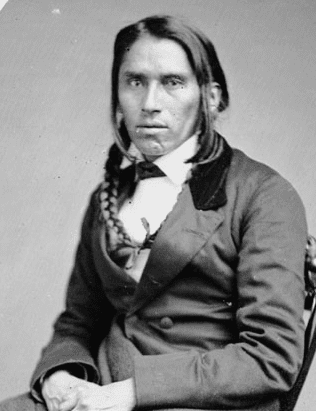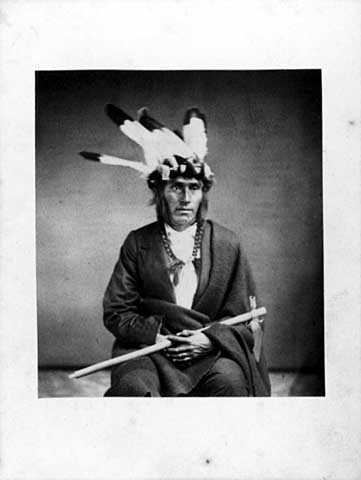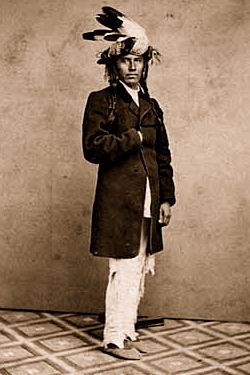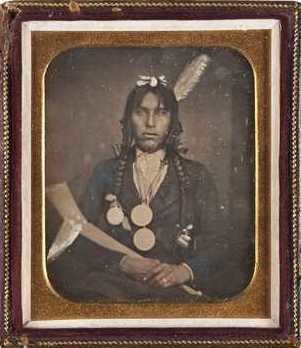Name Hole the | ||
 | ||
Native report hole in the day history
Hole in the Day (The Younger) c.1825-1868, was a prominent chief of the Ojibwe native people of Minnesota. The Ojibwe pronunciation has been written in various spellings such as Bagone-giizhig, Bagwunagijik, Bug-o-nay-ki-shig, Pugonakeshig or Puk-O-Nay-Keshig. Hole-in-the-Day has also been called Hole-in-the-Sky. The name probably refers to a dream in which the guardian spirit was seen through an opening in the sky. Some have speculated that the name refers to an eclipse of the sun, or an opening in an overcast sky through which sunlight is streaming down.
Contents
- Native report hole in the day history
- Hole in the day written performed by ann reed
- Biography
- During the 1862 Dakota War
- The Assassination
- References

Hole in the day written performed by ann reed
Biography

In 1847 Hole in the Day (the Younger) succeeded his father, Hole in the Day (the Elder), as head chief of the Mississippi Band of the Ojibwe(Chippewa) of central Minnesota. Like his father, Hole in the Day the Younger was prominent in skirmishes against the Sioux(Dakota), and was prominent in negotiations with the Dakota and with the U.S. government. Hole in the Day the Younger strove to be considered the head chief of all Minnesota Ojibwe. Most white government officials actually did consider him to be head chief in Minnesota. This was due to his ambition to be involved in most, if not all, important negotiations and other dealings between the Minnesota Ojibwe and the US government, and that he presented himself in an articulate and stately manner. However, many of the other Ojibwe leaders in Minnesota did not recognize him as the head chief.
During the 1862 Dakota War

During the Dakota War of 1862 in Minnesota, Hole in the Day the Younger spoke out in favor of joining forces with the Dakota to drive European settlers from Minnesota. His threats to attack and take control of Fort Ripley caused a great amount of tension at the fort. To help encourage Minnesota Ojibwe to join the battle, he spread a false rumor that the federal government was drafting Ojibwe men to become soldiers in the ongoing Civil War. Largely in reaction to this rumor and warlike coaxing by Hole in the Day, a group of Leech Lake Ojibwe burned the Indian Agency in Walker, took prisoners, and marched to Crow Wing. Some other Ojibwe chiefs did not agree with the idea of going to war against the whites and sent Ojibwe fighters to Fort Ripley to help protect the fort against a possible attack from forces incited by Hole in the Day.
The Assassination

Hole in the Day the Younger was assassinated by gunshot on June 27, 1868 near the Crow Wing Agency by a group of at least twelve Ojibwe men. He was several miles from his home, on his way to argue against the planned removal of the Mississippi Ojibwe to a reservation at White Earth. This was Indian on Indian crime on Indian land, thus at this time white officials had little authority to get involved. Hole in the Day's death was national news, and rumors of its cause were many: personal jealousy, retribution for his claiming to be head chief of the Ojibwe, retaliation for the attacks he fomented in 1862, or retribution for his attempts to keep mixed-blood Ojibwe off the White Earth Reservation. For decades the assassination remained a mystery. The identification of the assassins was known, however no one was ever charged with the murder. The truth about the assassination was eventually revealed to the public in 1911. Angry at having never been paid, some of the assassins, as old men, confessed that they had been hired by a group of mixed-blood traders led by Clement Beaulieu to kill Bagone-giizhig. Hole in the Day was originally given a Christian burial in the Crow Wing Catholic cemetery. In 1957 a white local resident illegally dug in the grave looking for valuable artifacts and discovered that there was no body. It is believed that Hole in the Day's relatives had removed his body and reburied him with traditional Ojibwe ritual in a secret location near White Earth village.

Besides Hole in the Day the Elder and Hole in the Day the Younger, there were at least two other prominent Minnesota Ojibwe of the 1800s named Hole in the Day. One Hole-in-the-Day from Red Lake was involved in the Nelson Act of 1889. Another Hole-in-the-Day from Leech Lake played a leading role in 1898 in the nation's last Indian battle, the Battle of Sugar Point.


